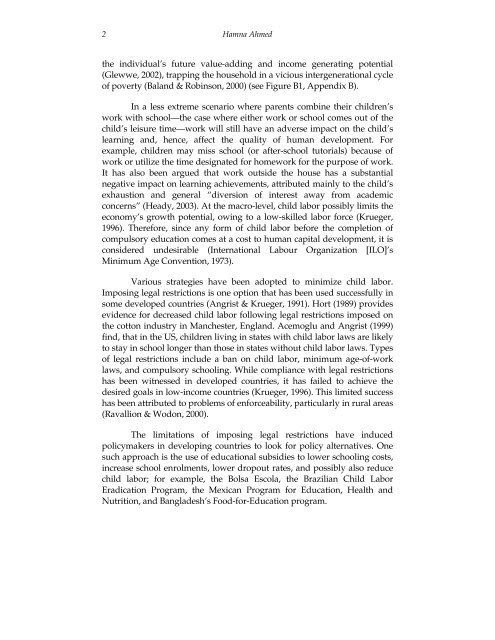The Impact of Public School Enrolment on Child Labor in Punjab ...
The Impact of Public School Enrolment on Child Labor in Punjab ...
The Impact of Public School Enrolment on Child Labor in Punjab ...
You also want an ePaper? Increase the reach of your titles
YUMPU automatically turns print PDFs into web optimized ePapers that Google loves.
2Hamna Ahmedthe <strong>in</strong>dividual’s future value-add<strong>in</strong>g and <strong>in</strong>come generat<strong>in</strong>g potential(Glewwe, 2002), trapp<strong>in</strong>g the household <strong>in</strong> a vicious <strong>in</strong>tergenerati<strong>on</strong>al cycle<str<strong>on</strong>g>of</str<strong>on</strong>g> poverty (Baland & Rob<strong>in</strong>s<strong>on</strong>, 2000) (see Figure B1, Appendix B).In a less extreme scenario where parents comb<strong>in</strong>e their children’swork with school—the case where either work or school comes out <str<strong>on</strong>g>of</str<strong>on</strong>g> thechild’s leisure time—work will still have an adverse impact <strong>on</strong> the child’slearn<strong>in</strong>g and, hence, affect the quality <str<strong>on</strong>g>of</str<strong>on</strong>g> human development. Forexample, children may miss school (or after-school tutorials) because <str<strong>on</strong>g>of</str<strong>on</strong>g>work or utilize the time designated for homework for the purpose <str<strong>on</strong>g>of</str<strong>on</strong>g> work.It has also been argued that work outside the house has a substantialnegative impact <strong>on</strong> learn<strong>in</strong>g achievements, attributed ma<strong>in</strong>ly to the child’sexhausti<strong>on</strong> and general “diversi<strong>on</strong> <str<strong>on</strong>g>of</str<strong>on</strong>g> <strong>in</strong>terest away from academicc<strong>on</strong>cerns” (Heady, 2003). At the macro-level, child labor possibly limits theec<strong>on</strong>omy’s growth potential, ow<strong>in</strong>g to a low-skilled labor force (Krueger,1996). <str<strong>on</strong>g>The</str<strong>on</strong>g>refore, s<strong>in</strong>ce any form <str<strong>on</strong>g>of</str<strong>on</strong>g> child labor before the completi<strong>on</strong> <str<strong>on</strong>g>of</str<strong>on</strong>g>compulsory educati<strong>on</strong> comes at a cost to human capital development, it isc<strong>on</strong>sidered undesirable (Internati<strong>on</strong>al Labour Organizati<strong>on</strong> [ILO]’sM<strong>in</strong>imum Age C<strong>on</strong>venti<strong>on</strong>, 1973).Various strategies have been adopted to m<strong>in</strong>imize child labor.Impos<strong>in</strong>g legal restricti<strong>on</strong>s is <strong>on</strong>e opti<strong>on</strong> that has been used successfully <strong>in</strong>some developed countries (Angrist & Krueger, 1991). Hort (1989) providesevidence for decreased child labor follow<strong>in</strong>g legal restricti<strong>on</strong>s imposed <strong>on</strong>the cott<strong>on</strong> <strong>in</strong>dustry <strong>in</strong> Manchester, England. Acemoglu and Angrist (1999)f<strong>in</strong>d, that <strong>in</strong> the US, children liv<strong>in</strong>g <strong>in</strong> states with child labor laws are likelyto stay <strong>in</strong> school l<strong>on</strong>ger than those <strong>in</strong> states without child labor laws. Types<str<strong>on</strong>g>of</str<strong>on</strong>g> legal restricti<strong>on</strong>s <strong>in</strong>clude a ban <strong>on</strong> child labor, m<strong>in</strong>imum age-<str<strong>on</strong>g>of</str<strong>on</strong>g>-worklaws, and compulsory school<strong>in</strong>g. While compliance with legal restricti<strong>on</strong>shas been witnessed <strong>in</strong> developed countries, it has failed to achieve thedesired goals <strong>in</strong> low-<strong>in</strong>come countries (Krueger, 1996). This limited successhas been attributed to problems <str<strong>on</strong>g>of</str<strong>on</strong>g> enforceability, particularly <strong>in</strong> rural areas(Ravalli<strong>on</strong> & Wod<strong>on</strong>, 2000).<str<strong>on</strong>g>The</str<strong>on</strong>g> limitati<strong>on</strong>s <str<strong>on</strong>g>of</str<strong>on</strong>g> impos<strong>in</strong>g legal restricti<strong>on</strong>s have <strong>in</strong>ducedpolicymakers <strong>in</strong> develop<strong>in</strong>g countries to look for policy alternatives. Onesuch approach is the use <str<strong>on</strong>g>of</str<strong>on</strong>g> educati<strong>on</strong>al subsidies to lower school<strong>in</strong>g costs,<strong>in</strong>crease school enrolments, lower dropout rates, and possibly also reducechild labor; for example, the Bolsa Escola, the Brazilian <strong>Child</strong> <strong>Labor</strong>Eradicati<strong>on</strong> Program, the Mexican Program for Educati<strong>on</strong>, Health andNutriti<strong>on</strong>, and Bangladesh’s Food-for-Educati<strong>on</strong> program.
















